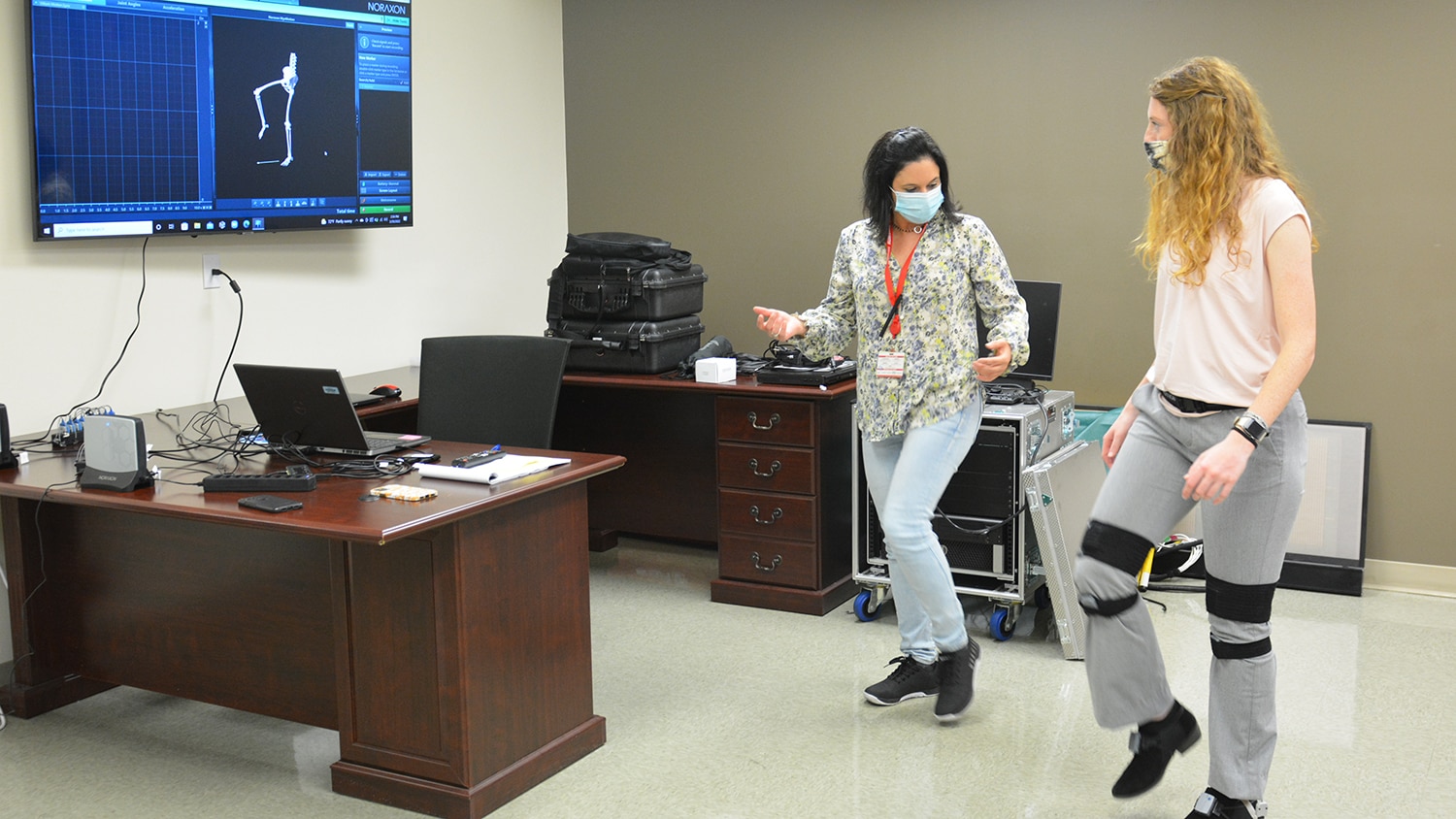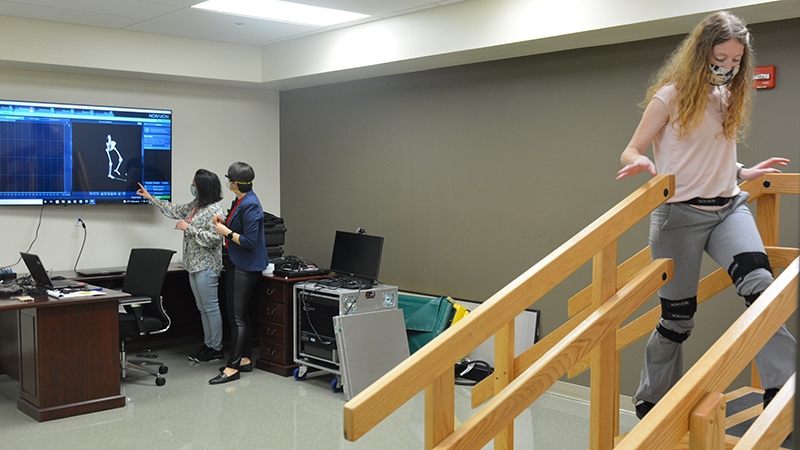View Larger Image

Nadia Marconi, left, demonstrates a motor task to a student volunteer, Mackenzie Williamson, while using the new motion-capture system.
Image by David Wise
Program’s New Motion Analysis Equipment Enhances Research, Education
| Mobility has come to the motion capture technology that the University of Arkansas for Medical Sciences (UAMS) Department of Physical Therapy uses for teaching graduate students and for research. Plans call for its use to be extended to patient care in the near future.
The previous generation of three-dimensional motion capture technology had to be used in a laboratory environment and was stationary. Now, the department’s faculty and students can operate it outside the lab to collect data in an environment that more closely mimics real life.

Elizabeth Garcia helps to place the motion-capture sensors on Williamson before the demonstration.David Wise
Noraxon makes and sells the new system, the Ultium Motion, the next-generation inertial motion capture system, which is equipped with a state-of-the-art sensor design that delivers accurate and reliable measurement of all types of movement.
“Our new system is entirely wireless and portable,” Nadia Marconi, Ph.D., said. “It means we can take the equipment anywhere and perform a motion analysis in any environment. Inertial measurement units (IMUs) like the one we possess use built-in accelerometers and gyroscopes technology to detect, respectively, acceleration and rotational movements”.
Besides sensors, the Department of Physical Therapy has wireless insoles which map foot pressure distribution and electrodes to register muscle activation patterns.
Marconi is an assistant professor in the UAMS College of Health Professions Department of Physical Therapy.
Movement researchers have used stationary, optical motion capture systems for decades, but the wireless, portable versions are gaining popularity in both research and clinical arenas due to their lower cost, user-friendly interface, and flexibility to collect data both indoors and outdoors
“Our system has been validated for healthy individuals without a history of neurological disorders,” Marconi said. “It’s important to compare our outcome data with the one collected using the “gold standard,” especially in populations with profound walking pattern deviations”.
If the study proposal is approved, then they will gather the data from patients with Parkinson’s disease who volunteer to help with the research. If the new system compares favorably with the gold-standard technology, then Marconi should be able to use it outside the lab with them and other patients with movement disorders.
“My idea is to use the system for research in outdoor environments,” Marconi said. “First though, we have to check the IMUs system with the validation study to see if it is reliable and accurate when identifying the changes or adaptations with those patients, then we will analyze their walking patterns when they walk out in the community.”
Marconi said although patient data generated in the lab is very helpful, it can’t be as realistic as what is collected beyond that environment.
“When we bring a patient in the lab, they have to walk a short distance,” Marconi said. “They don’t have the same challenges as when walking outdoors. Taking this system to analyze how they move in a real-life scenario is going to give us a fuller picture of what is going on. When they need to go to a grocery store or cross a parking lot, that is when they need to face their challenges.”
Patients often can feel bombarded by sounds in noisy, crowded places and other sensory inputs from outside that can make them unsettled and unsure of their ability to navigate across a space, she said.
Marconi said, “I am particularly interested in investigating the motor control and biomechanical strategies my patients use to navigate real-life conditions, such as their homes or community. Understanding these strategies and the most common adaptations is crucial to determining the best physical therapy care for them.”
“They’ll say they are 80% confident walking in the clinic but only 40% confident walking across a Walmart parking lot,” Marconi said. “That is real life.”
Motion analysis in physical therapy is evolving more and more to the analysis of movements in situations everyone encounters almost every day.
That’s why the mobile motion capture systems are important to research and also to training new physical therapists.
“The Doctor of Physical Therapy students need to be open to learn about these technologies because they are becoming more and more portable and wireless,” she said. “We have many clinics and hospitals that are acquiring it. In the future, they may work in a facility with it, so they need to be prepared in how to use it.”

Marconi, left, and Garcia discuss an image on a television monitor in the lab while they have Williamson climb a staircase.David Wise